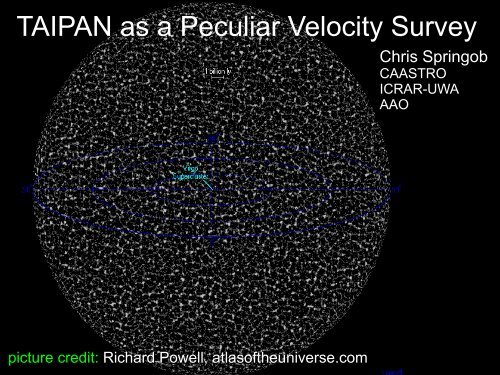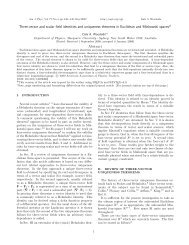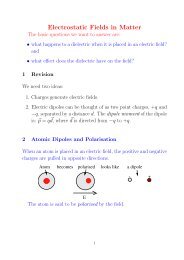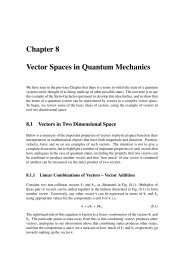TAIPAN as a Peculiar Velocity Survey
TAIPAN as a Peculiar Velocity Survey
TAIPAN as a Peculiar Velocity Survey
- No tags were found...
You also want an ePaper? Increase the reach of your titles
YUMPU automatically turns print PDFs into web optimized ePapers that Google loves.
<strong>TAIPAN</strong> <strong>as</strong> a <strong>Peculiar</strong> <strong>Velocity</strong> <strong>Survey</strong>Chris SpringobCAASTROICRAR-UWAAAOpicture credit: Richard Powell, atl<strong>as</strong>oftheuniverse.com
OutlineqqHow does <strong>TAIPAN</strong> fit in with other peculiar velocity surveys?Using <strong>TAIPAN</strong> redshifts to build better peculiar velocity fieldmodels
●●Me<strong>as</strong>uring large scale motionspeculiar velocity—the velocity of a test particle(galaxy) separate from its velocity due to theoverall Hubble expansion– caused by the gravitational attraction of nearbymatter overdensitiesGiven the peculiar velocity field v(r), , can infermatter density field, which gives youcosmological parameters
Me<strong>as</strong>uring peculiar velocities = me<strong>as</strong>uring distances●How do you me<strong>as</strong>ure peculiar velocities?– Use a redshift independent distance indicator:cz obs= H 0r + v pec
Me<strong>as</strong>uring distances: primary vs. secondary distanceindicators●Primary distance indicators: distance me<strong>as</strong>urementdoesn't require calibration by another method– Variable stars (Cepheids, RR Lyrae stars)– Tip of the Red Giant Branch– Eclipsing binaries• Secondary distance indicators: distance me<strong>as</strong>urementmust be calibrated by the distance scale derived fromprimary distance indicators– Surface brightness fluctuations– Type Ia supernovae– Tully-Fisher relation– Fundamental Plane relationOnly TF (spirals) and FP (ellipticals) from photometry +spectroscopy can give you peculiar velocities for thousandsof galaxies.
What's the optimal survey design fora peculiar velocity survey?●●●●Largest possible number of galaxiesSmallest possible distance / peculiar velocityerrorsWidest possible sky coverageLargest possible survey volume
“Current” generation peculiar velocity surveys●●Tully-Fisher surveys– SFI++: M<strong>as</strong>ters et al. (2006); Springob et al. (2007)– ~4500 galaxies– 2MTF: M<strong>as</strong>ters, Huchra, & Springob (2008)....nowHao, Springob, M<strong>as</strong>ters... – ~3500 galaxies– Cosmic Flows: Courtois & Tully 2012 – ??? galaxies(mostly cz
There are more TFgalaxies in theuniverse, but FPsurveys tend to godeeper.Redshift histogramfor SFI++ (blue) and6dFGS (red).
Why go to deeper redshifts?blue shading = top-hat filter(90% probability)green shading = Gaussianfilter (90% probability)
Getting cosmology out of cosmography:If bulk flow is 2MRS large, prediction is it because Λ-CDM needs 6dFGS revision, observation orbecause we happen to live in a region with unusually largesuperclusters / voids that induce the large bulk flow?2MRS prediction6dFGS observationAbove: smoothed predicted velocity field from 2MRS (left) and observedvelocity field from 6dFGS (right) for a slice through the supergalactic plane (-20 < SGZ < +20 Mpc/h). Redder colors correspond to more positive peculiarvelocities; bluer colors to more negative peculiar velocities.
WALLABY – Wideband ASKAP L-band Legacy AllskyBlind SurveYWALLABY (ASKAP) + WNHSS (Westerbork)Left: Simulated skyand redshiftdistribution(Beutler).How many of these are detectable, i>45 o , ΔV > 80 km/s?
<strong>TAIPAN</strong> Fundamental Plane <strong>Survey</strong>●●What would the survey look like?Christina Magoul<strong>as</strong>'s 6dFGS mock generationcode....input:– Apparent magnitude limit = either 1 or 1.5 magsfainter than 6dFGS in J-band (14.65 or 15.15)– <strong>Velocity</strong> dispersion limit = 70 km/s– cz limit = 30,000 km/s– All southern hemisphere survey—nothing north ofdecl. = 0 o
Right:Simulatedredshifthistogram for<strong>TAIPAN</strong> FP,<strong>as</strong>suming a J-bandmagnitudelimit of 15.15(blue) and14.65(green). Alsoshown is theactual redshifthistogram for6dFGS FP(red).<strong>TAIPAN</strong> mock redshift distribution
●Model velocity fields <strong>as</strong> derived fromredshift surveysTake an all-sky redshift survey:– Reconstruct the predicted peculiar velocity field,<strong>as</strong>suming galaxy distribution traces matterdistribution, and b=δb=δ gal /δ m<strong>as</strong>s– Some of the cosmological analysis comes fromanalyzing the observed peculiar velocities on theirown, but some analysis involves comparing to thepredicted peculiar velocity field.
As described byErdogdu et al.(2006), reconstructthe velocity field,<strong>as</strong>suming mattertraces 2MRS galaxydistribution.The 2MRS velocity fieldRight: Thereconstructed peculiarvelocity field for 2MRS(11.25 mag. limitsample.).
All sky redshift survey....can we do better?Source: Huchra et al. (2011) Table 1.
Conclusions●●●Current generation of galaxy peculiar velocities each have~3000 to ~10,000 galaxies—with WALLABY and <strong>TAIPAN</strong>,we can grow this by an order of magnitudeWALLABY & <strong>TAIPAN</strong>, <strong>as</strong> peculiar velocity surveys, will becomplementary—the former giving us peculiar velocitiesfor the spirals, and the latter for ellipticalsThe redshifts from <strong>TAIPAN</strong> will also be useful to peculiarvelocity studies, in that one can reconstruct predictedpeculiar velocity field models from redshifts alone.– It would be great if we could get complementaryredshifts in the north <strong>as</strong> well!
Extra slides
qqGalaxy peculiar velocitiesCan be used for:CosmologyCosmography
Different velocity fieldreconstructionsagree with eachother in terms ofgross features, butdisagree in thedetails, and do notreproduce CMBdipole.
• you <strong>as</strong>sume that the matter density field is ahomogeneous background, , with smallperturbations on large scales: the linearapproximation to gravitational instability theorywhere f(Ω)=~Ω m0.55(r)=m<strong>as</strong>s overdensitym<strong>as</strong>s
Evolution of density field with time:v pec(x,t)= 0(x)f(t)density grows “self-similarly”pecfield gives us present-day m<strong>as</strong>s field, which isthe same <strong>as</strong> initial density perturbations!
















